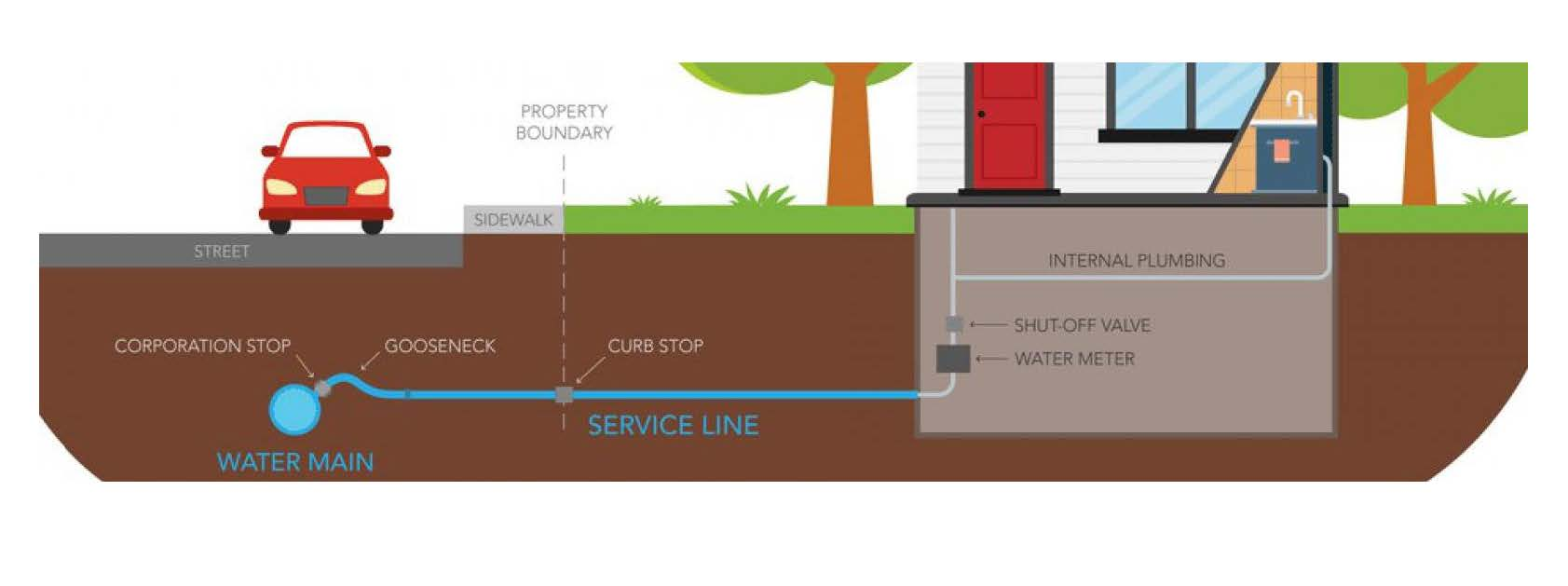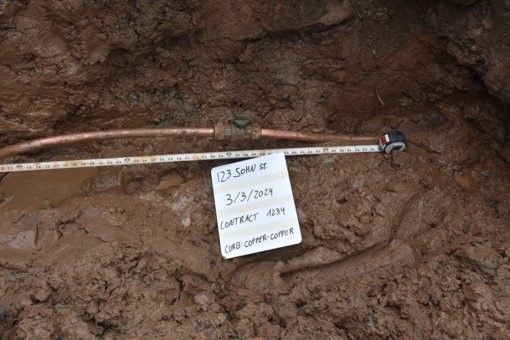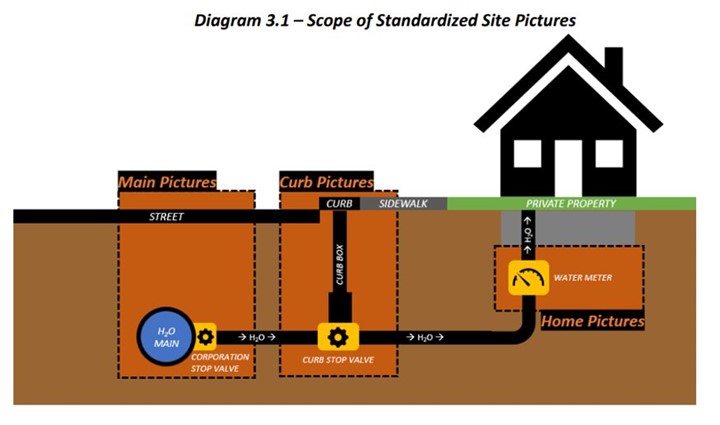Lead Service Line Replacement Guidance
Requirements for Lead Service Line Replacement (LSLR) Projects
Lead service line” means a water supply connection that is made of, or lined with, a material consisting of lead, and which connects a water main to a building inlet. A lead pigtail, lead gooseneck, or other lead fitting shall be considered to be a lead service line, regardless of the composition of the service line or other portions of piping to which such piece is attached. A galvanized service line shall be considered to be a lead service line. A lead service line may be owned by the public community water system, a property owner, or both. These pipes can be a significant source of lead contamination in drinking water. In July 2021, Governor Phil Murphy signed into law P.L.2021, Ch.183, which requires community water systems in NJ to identify all lead service lines, provide public notification regarding the presence of all lead service lines, and replace all lead service lines by 2031. All community water systems must meet federal and State laws and regulations concerning lead service lines.
- EPA Lead and Copper Rule
- EPA Lead and Copper Rule Revisions (LCRR)
- EPA Proposed Lead and Copper Rule Improvements (LCRI)
- NJDEP Reducing Potential Risks from Lead in Drinking Water
- NJ Safe Drinking Water Act N.J.A.C. 7:10
Public vs. Private Components
- Public Portion: This typically includes the section of the service line from the water main in the street to the property line. It is usually owned and maintained by the water utility.
- Private Portion: This includes the section of the service line from the property line into the building. This portion is typically the responsibility of the property owner.
Components to be Replaced
- Corporation Stop: This is a valve that connects the service line to the water main. If connected to lead pipes, it is recommended to be replaced.
- Curb Stop: This is a valve that connect the public and private service line. If connected to lead pipes, it is recommended to be replaced.
- Gooseneck or Pigtail: These are short, flexible connectors often made of lead, used to connect the service line to the water main or other piping. They must be replaced as part of the lead service line replacement process.
- Service Line Pipe: Any portion of the service line pipe, both public and private sections, must be replaced if it contains lead. If both the public and private sections contain lead and the homeowner does not agree to replacement, it is not allowable to replace only the public side, unless in the event of an emergency such as a water main or service line break.

NJ Water Bank LSLR Project Requirements
All LSLR projects financed in full or part by the NJ Water Bank are required to follow additional requirements throughout the life of the project.
1) Engineering Agreements for LSLR Projects
The DEP requires LSLR project engineering agreements to include LSLR specific items in their scope of work. See the Engineering Checklist to learn more.
2) Monthly Site Inspection Reports
The engineering contractor must submit monthly site inspection report data, with minimum required fields to the DEP on the 10th of the month for the previous month. Minimum required fields and further instruction can be found in the engineering checklist.
Submittals include photographs of each replacement, in compliance with the following:
-
- Excavated curb stop to document the materials and condition of the existing utility-side and customer side service lines.
- Clear documentation of the completed service replacement
- Photograph(s) must include geographic coordinates.
- Photographs must conform to the NJDEP-established standards (see Figure 2).
- For photographs of both pre-construction and post-construction service line replacements, a recommended 18 inches of line must be visible after each connection or valve for both homeowner side and utility (main) side replacements.
As shown in Figure 3, photos should be taken in 3 locations.
-
- Water Main Picture taken at the Corporation Stop Valve under the street
- Curb Picture taken at the curb stop valve
- Water Meter picture taken near the home
3) Pay Requisition LSLR Data
The DEP requires submission of data for each LSL replacement for the period worked for each payment requisition. This data must be submitted in excel format (.xlxs or .cvs) and include all data fields listed in the LSLR Payment Requisition Spreadsheet Template.
4) Enhanced Inspections
All LSLR projects financed in full or part by the NJ Water Bank will be subject to inspections as follows:
NJDEP Quarterly Inspections
Minimum once-per-quarter inspection
Quarterly inspections are scheduled
Deficiencies are noted in a post-visit letter
Additional NJDEP Inspections for LSLR Projects
Additional 1-3 week inspection cycle
Inspections are unannounced
Inspection is recorded in GIS survey
Deficiencies for additional inspections are noted in a post-visit correspondence


Frequently Asked Questions
What components of a lead service line replacement project are eligible for funding through the NJ Water Bank?
- Lead Service Line Replacement: Both the public and private sides of the lead service lines are eligible for replacement funding. Principal forgiveness funds are earmarked specifically for the customer side replacement, reflecting a priority to mitigate lead exposure directly at the consumer level.
- Test Pitting: This involves conducting exploratory digs to accurately locate and assess the condition of existing lead service lines. The costs associated with this crucial preparatory step are covered under the funding guidelines.
- Provision of Water Filters: To ensure immediate access to safe drinking water, especially during the transition period, the provision of water filters to affected customers is an eligible expense. This measure is essential for reducing any potential lead exposure during and after the replacement process.
If a water system does not own any of the service lines in the service area, what is the system’s responsibility for replacement?
Regardless of who owns the service line (customer vs water system), the water system is responsible for ensuring that these lines are replaced and must create a plan to do so. In practice, this means that water systems must set up a service line replacement program and offer to replace the service lines on behalf of the customer. The water system is not responsible for paying for the portion of the service line that they do not own.
Is a water system responsible for paying for private side/customer owned lead service line replacement?
No. For an investor-owned water system, costs associated with undertaking and funding the replacement of lead service lines, excluding any portion funded by grants or other subsidies, shall be borne by all of the customers within the State of the water system, and shall be included in the water system’s rate base or otherwise be recoverable from the system’s customers, in a manner determined by the NJ Board of Public Utilities. For government-owned community water systems, any costs incurred for assessment and replacement of lead lines, excluding any portion funded by grants or other subsidies, may be borne by all of the customers of the government owned public water system OR may be assessed to a property of a property owner.
What should water systems do if a customer refuses to have their line replaced?
The Department recommends making a good faith effort in obtaining customer cooperation in conducting lead service line replacements. The Department recommends asking at least once annually after the initial request to gain access to private property for replacement. Checking in annually is important as the property owner or situation may change. EPA’s Lead and Copper Rule Improvements (LCRI) requires that a water system must make at least four attempts to contact a customer using two different communication methods to have their consent to replace their service line. If those attempts are not successful, EPA’s LCRI states that if a water system is unable to gain access to conduct a full service line replacement, the water system is prohibited from replacing any portion of the service line (with few exceptions).
Water systems should record outreach attempts to customers. The Department has developed a form to assist water systems with tracking efforts, as well as a form to document customer refusals. Both can be found on the Department’s Lead Additional Resources website: https://www.nj.gov/dep/lead/resources.html. A water system should ensure that a public outreach program is in place and that property owners in its service area are being educated on opportunities to replace their lead service lines as well as the potential health effects of lead.
How far must the service line be replaced into the home? Where does premise plumbing start?
All lead portions of the service line must be removed. In most cases, the lead service line portion may extend into the property at a minimum of three (3) feet after the building inlet. In properties where the meter extends beyond three (3ft), the lead line shall be replaced past the meter and up to the shut-off valve.
Water systems cannot do a partial service line replacement (only replacing the system owned side and leaving the customer owned side to be replaced at a later time) unless it is an emergency or part of a main replacement project. If those situations do not apply, the sponsor cannot replace their half of the line and come back to replace the customer’s half later. The Lead Service Line Replacement Law in NJ specifically addresses that point, prohibiting partial service line replacements. The Sponsor must replace the full service line at the same time.
Are water systems required to provide filters with lead service line replacements?
Water systems are not required to provide filters until October of 2027, but we encourage them to do so in the meantime as feasible.
EPA has placed restrictions on funding galvanized service line replacements using Bipartisan Infrastructure Law funds. Will DWSRF be able to fund my galvanized service line project?
EPA has instructed all states that FFY24 and future Bipartisan Infrastructure Law funds for Lead are only to be used for lead service lines, or galvanized service lines that were previously or currently downstream of lead. However, NJDEP has remaining funds from previous fiscal year allocations that can be used for galvanized service line replacements, as well as other packages should those funds not be available. If a water system has specific questions about funding available to them for a project, please reach out to schedule a meeting to discuss further.